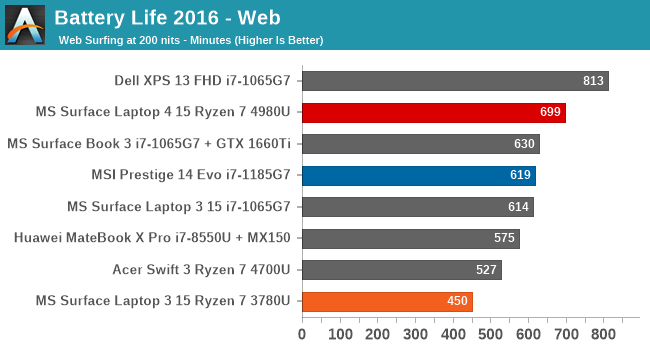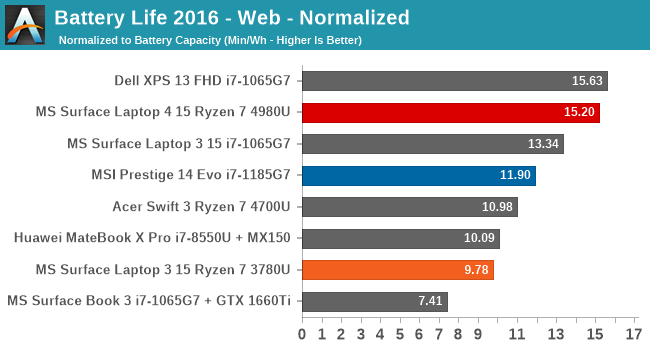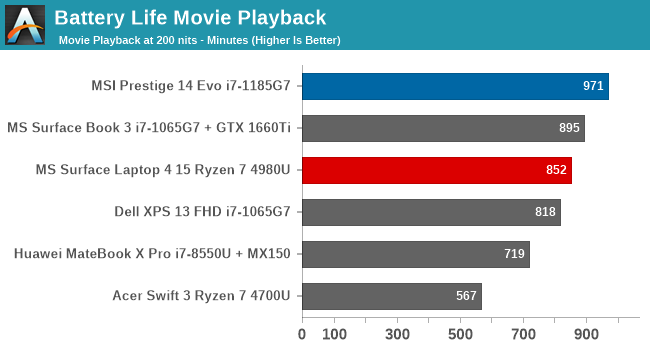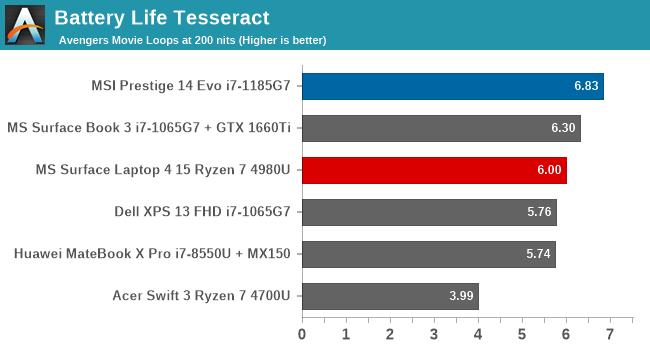The Microsoft Surface Laptop 4 15-Inch Review: Refreshing Ryzen
by Brett Howse on May 6, 2021 8:00 AM ESTBattery Life
On the Surface Laptop 3, the battery life disparity between the AMD Picasso and the Intel Ice Lake was a big enough factor on its own to make it difficult to recommend the AMD-powered Surface Laptop 3 over the Intel version. However, for this generation the tables have turned. Microsoft’s recommendation when choosing AMD versus Intel, is choose the Intel for single-threaded performance, but choose the AMD not only for multi-threaded performance, but for battery life as well. While the gulf between Tiger Lake and Renoir is not as dramatic as it was between Picasso and Ice Lake, that is still a very interesting change in marketing.
Microsoft has said that they worked very closely with AMD on increasing battery life on the Surface Laptop 4, and these improvements will only benefit all AMD buyers for any device, which is why it was such good news to see AMD get a design win in the Surface Laptop 3 in the first place. With the Surface Laptop 4, those improvements to the APU design, coupled with tweaks to the operating system, have really paid dividends.
Battery Life – Web

The battery life provided by the Surface Laptop 4 is really quite incredible when you factor in that this is a 15-inch notebook, and the display is always the source of most of the battery drain, and when you consider that Microsoft is only including a 46 Wh battery, which is very small for a 15-inch device. At over 11.5 hours, the Surface Laptop 4 offers very solid battery life in our web test, which is quite demanding.

Looking at the normalized results with the battery size removed from the equation, and it shows just how efficient the Surface Laptop 4 is. Despite having a larger display than the Dell XPS 13, it almost equals that device in terms of power draw. It is very impressive.
PCMark 10

UL’s PCMark 10 suite added a battery life test as well, and it works by looping some of the workloads from their performance tests in ten minute loops, but it takes into account performance as well by having a fixed workload per ten minutes, so if a device gets the task done quicker, it will have a larger percentage of the ten minutes that it can idle. The results are still excellent, with the Surface Laptop 4 offering one of the best results we have seen so far.
Movie Playback

Media playback is often one of the least demanding tasks on a modern processor, because all of the video decode functionality is handled by very power efficient fixed function hardware in the media engine, and as such, generally results in the longest runtimes of any test. Here, the Surface Laptop 4 delivers a very solid result, although the Tiger Lake MSI, and the Surface Book 3 with its massive battery, are both able to beat it in terms of overall runtime.

To get a feel for what these results mean, our Tesseract score divides the movie playback runtime by the length of The Avengers. You could watch The Avengers six times in a row, which is likely enough times for anyone but the biggest fan of the movie.
Charge Time
Microsoft ships the Surface Laptop 4 with a 65-Watt power adapter, which magnetically attaches to the right side of the device on the Surface Connect port. Microsoft continues to provide a 5-Watt USB Type-A port on the power adapter itself, which works great to charge an ancillary device such as a phone from the same charger, and is a great feature. This leaves 60 Watts for the laptop from the power adapter.
There is also a USB Type-C port on the left side which will allow you to charge from a USB Type-C cable if needed.

Charge time is about average, despite the small battery and fairly large charger. The previous generation completed this task a bit quicker when it was tested. The first 50% only took 41 minutes to complete.











98 Comments
View All Comments
Reflex - Thursday, May 6, 2021 - link
This list is silly. Almost all of the things you mention are mostly accessed wirelessly these days. USB-A to USB-C adapters are super cheap and Anker sells a nice line of USB-C hubs that provide additional ports if you truly need them. I have one in my bag due to my Dell laptop having only 2 USB-C ports, but I can't even remember the last time I needed to use it.There are excellent actual bluetooth mice out there, I use a Microsoft one.
Who is using their optical drive on the go, or really at all?
Your storage is better in the cloud or on the network, again how most people use it nowadays.
Also, printers, can you even buy a decent printer that isn't wireless now?
And again, bluetooth keyboards are a thing and they are cheap.
Just bizarre list. Reads like someone stuck in computing from 15 years ago.
If this is your list of needs, modern ultrabooks are not for you.
Kevin G - Thursday, May 6, 2021 - link
Or people reasonably can't afford to repurchase everything. A cheap just to get it done wired mouse can be had for as little as $5 where as a good BlueTooth mouse starts at $20. The kicker is that people already have a wired mouse they could plug-in and use. Yeah, $20 in the grand scheme of things but when you have pay that extra amount five or six times, it starts to get noticed by the masses especially on top of the price of a new ultrabook.Ditto for printers. If you've saved up and purchased a unit years ago and is humming along nicely, why replace it with something new? At some point it does make sense to upgrade due to the lack of ink/toner available on the market or it just breaks down, but realistically things can last a very long time.
My Dell 5540M I'm currently using has two USB-A and one TB3 port and I often find myself limited. I use a lot of hardwired networking to isolated networks so there goes one port dedicated to that. The wired networking port generally gets the TB port even though it is type-A and I'll need an A-to-C adapter. One Type A goes to a wired mouse since it also doubles as a mouse for some systems that either have BT disabled or no wireless connectivity at all (and i'm not going to carry a second one if i don't have to). The remaining type A is often used for removable storage or a wired audio device. Thankfully I still have a dedicated barrel power jack. The TB3 port also supports power in a pinch and I borrowed other people's type-c chargers in an emergency. There are indeed times where I wish I had four USB ports.
I also do have access to a USB external optical drive which I pull out once or twice year to access an old physical media file. I've probably had this over half a decade with the same relative pace of usage and probably will keep on to it until it break at what point I imagine it'll pass the decade mark. My coworkers know I have it and again a few times a year one will ask to borrow it for a similar one-off data transfer. Migrating data to the network/cloud is a generally a good idea but it takes time, has costs (and monthly costs for the cloud) associated for it and a small amount of skill on the user's end.
simonpschmitt - Friday, May 7, 2021 - link
While your desccribed use case seems to need more (USB) ports at times most of it could be managed by a cheap USB-hub.Additionally, you must admit that this is beyond propably 99% of computer users out there.
Most people don't use one mouse for more than one computer.
Actually everyone I know outside IT does not use wired networking on a mobile device.
For my sisters (both teachers) and parents (small buisness owners) switching everything possible to wireless was propably the best quality of live upgrade since they use computers.
Kevin G - Monday, May 10, 2021 - link
Hubs can be problematic vs. having the port natively in a device. Large capacity hubs or those that can power other devices require AC outlets. Small data only hubs exist but generally are not the highest quality. Hubs also run the risk of some one tripping over a cable and unplugging everything off of that hub (uplink is disconnected) vs. a single device. A single home run to the host device is strongly preferred where every possible. This also applies to various adapters from say USB-C to DisplayPort: a single cable with the proper ends is preferred over a USB-C to female DP port and a DP-to-DP cable. Simply less to go wrong in the single path and you carry around less.Wired networking is critical for me as I often work on isolated, wired networks. There have been at times where I've been on two independent wired networks and still had wi-fi going. I realize that my use-case is rather specific but it does drive home the more general idea that the number of USB ports on a system is restrictively small, especially if they're pulling double duty for the likes of power, video, audio and networking.
PaulMack - Thursday, May 6, 2021 - link
I've had a Surface for some time and, while the limitation to one USB port is occasionally annoying, it's never been for a mouse. It's a premium device, and it's not unreasonable to spend $/£/€50 on a Bluetooth mouse. I only ever hit the limit when connecting a memory stick and another peripheral, and that's rare when on the move without the dock.MrCommunistGen - Thursday, May 6, 2021 - link
You can get a pretty inexpensive travel USB-A 3.0 hub for less than $20. I just keep one in my travel bag. A quick search turned up two different 4-port models for $13-15.yankeeDDL - Friday, May 7, 2021 - link
By "expensive adapter" you mean something like this (25usd)? https://www.amazon.com/-/es/Adaptador-USB-Hub-Mult...Using more than 2 USB port at the time is quite rare. Yes, more ports would help, but clearly teh space is rather limited.
Spunjji - Friday, May 7, 2021 - link
If you're using an external optical drive and a printer then you can probably handle using a hub, too.29a - Friday, May 7, 2021 - link
People giving presentations often need more than one USB port which I can see this laptop being used to give a lot of presentations. A flash drive and a Powerpoint presenter are both commonly used when giving presentations, that's two USB ports there.philehidiot - Sunday, May 9, 2021 - link
Typical use case for a business machine - running software that requires a USB dongle to operate. Removing it disables the software. One port down. Need to charge? Both down. How about people who leave a low profile USB drive in a slot for local back up purposes? If my livelihood is based on what is on that machine, I've got a local backup running as well as cloud.Sure, plug in a USB C dongle with a wire and giant block with all the connections you'll need (because having a different one for every use is expensive and fiddly) and you'd better not be using the laptop on your lap on a train or in a car. It'll dangle off your lap, yanking on the port constantly.
A business laptop, in my humble opinion, should have three available ports as a minimum. But as others have said here, they are likely working on feedback from telemetry and real world use. 95% of people don't use it so screw 5%.
In my view, a business laptop like this, with such an asking price should be putting in the extras that ensure more than the bare minimum for the majority. The people who have a use case as I have suggested above simply won't buy it, so it won't be their problem.